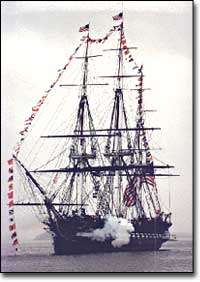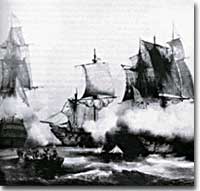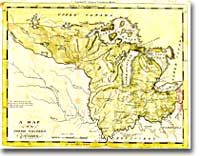19b. Negotiating with the Superpowers

The USS Constitution, launched on October 21, 1797, is the oldest commissioned warship still afloat.
The United States was a small new country. Regardless, it found itself in the midst of the dramatic escalation of political and military conflicts brought on by the French Revolution.
President Washington declared American neutrality in the war, breaking the terms of a 1778 treaty with France that had promised mutual assistance between the two countries. While France had aided the U.S. during the American Revolution, America would not do the same for France.
Washington's decision stemmed from his philosophical commitment to non-involvement in foreign affairs, but was also based upon pragmatic considerations. Ninety percent of all U.S. imports came from Britain and customs duties on these imports produced ninety percent of federal revenues.
The conflict in Europe created an immense opportunity for Americans. Farmers, merchants, and ship owners all stood to profit from the long European war and even American manufacturers were shielded from massive cheap imports from the Old World. The war stimulated a broad recovery of the American economy.

The assistance of American privateers was essential throughout the American Revolution and later during the French Revolution.
In the face of American neutrality that would continue a strong economic relationship with Great Britain, the French government sent Edmond Genet to the U.S. as a diplomatic envoy. Controversially, Genet was instructed to enlist American aid for the French Revolution even though Washington had established a clear policy of neutrality.
In the face of this, Genet called for American privateers to harass British ships and also opened up the French sugar islands in the Caribbean for free trade with U.S. ships. Supporters of the French Revolution, as well as those who stood to benefit from the new lucrative trade opportunities, rallied to support Genet's mission. On the other hand, Federalists saw him as a renegade who broke American laws. The French superpower clearly showed to qualms about trying to force the hand of the new American republic.
Britain responded to the offer of French free trade by seizing American ships that they suspected of carrying French goods. While Americans saw this as a deep violation of their national sovereignty and right to trade as a neutral nation, the British dismissed American claims to free trade as merely war time profiteering with the enemy.

The Northwest Territory encapsulated land that would later become Wisconsin, Illinois, Indiana, Ohio, Michigan and parts of the Dakotas, Minnesota and Montana.
At the same time, the British still occupied forts in the American northwest that were supposed to have been abandoned by the terms of the peace treaty of 1783. Not only did the British army still not surrender these strategic strongholds, but they also supplied Native Americans with goods and encouraged them to attack the U.S. from the west.
While France ignored American neutrality, the British engaged in covert and explicit acts of war. Washington responded to the aggressive British actions by sending John Jay, the first Chief Justice of the Supreme Court, on a diplomatic mission to England. He negotiated an extremely broad agreement that dealt with issues from repaying pre-Revolutionary debts, to the British forts in the west, and the rights of free trade across the Atlantic. Jay's Treaty proved to be enormously controversial and historical judgments about its strengths and weaknesses remain sharply divided.
Clearly, America lacked the strength to force powerful Britain to capitulate on key issues. As a result the agreement largely strengthened American ties to Great Britain and was bitterly denounced by the growing political opposition to Washington and his administration. Jay became the victim of harsh public protests that included burning him in effigy. The controversial treaty passed the senate with the minimum number of votes even with Washington's total commitment to its success.
The American republic was caught between the two great superpowers of the day.






